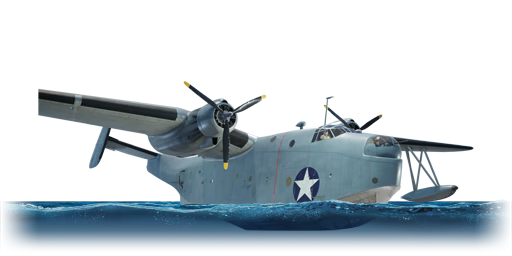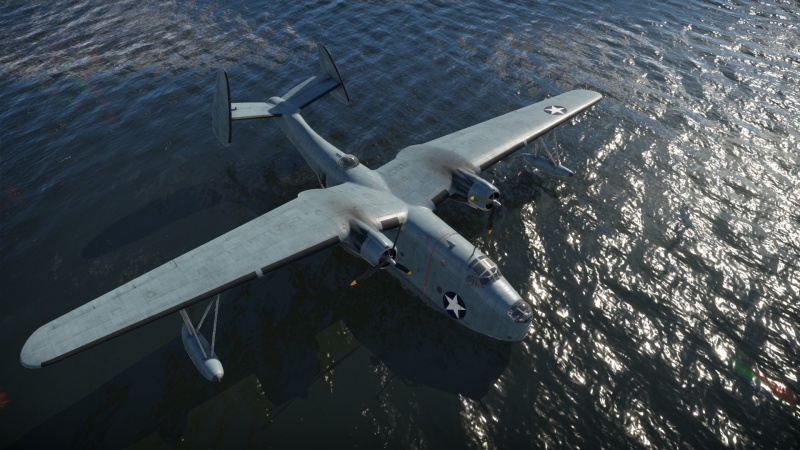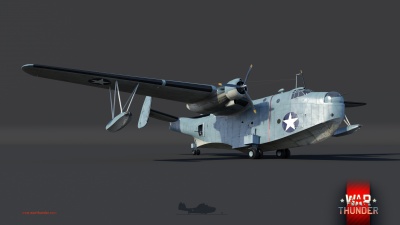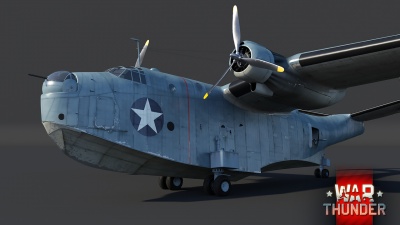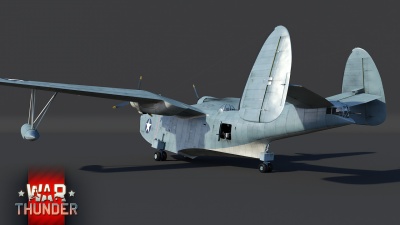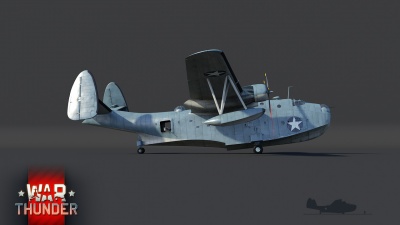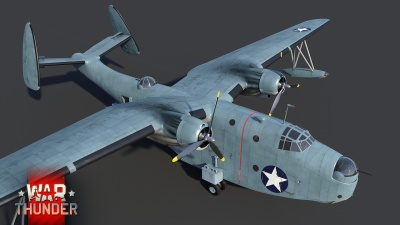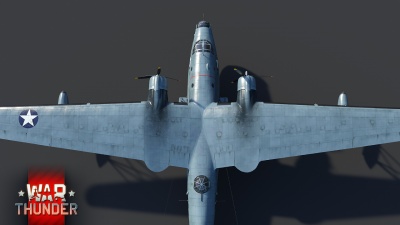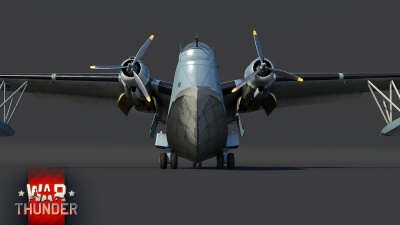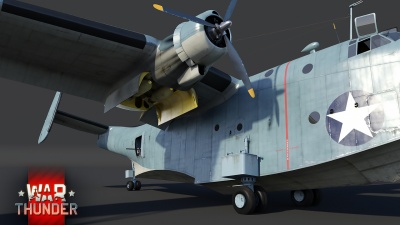PBM-3 "Mariner"
| This page is about the American bomber PBM-3 "Mariner". For the other version, see PBM-1 "Mariner". |
Contents
Description
The PBM-3 "Mariner" is a premium gift rank II American bomber with a battle rating of 3.0 (AB/RB/SB). It was introduced during Update 1.85 "Supersonic" as part of the Sea Voyage event that ran from 21 February to 11 March 2019.
General info
Flight performance
Due to the fact that it is a large seaplane, the PBM-3 is not very manoeuvrable and has trouble banking. However, when you get into a high-angle bank, it does turn fairly easily because of its large wings. As for payloads, it doesn't matter which payload you take for flight performance. All of the bombs are contained in the nacelle-mounted bomb bays and won't have a large difference in manoeuvrability.
| Characteristics | Max Speed (km/h at 3,962 m) |
Max altitude (metres) |
Turn time (seconds) |
Rate of climb (metres/second) |
Take-off run (metres) | |||
|---|---|---|---|---|---|---|---|---|
| AB | RB | AB | RB | AB | RB | |||
| Stock | 336 | 325 | 6200 | 34.4 | 35.3 | 3.5 | 3.5 | 585 |
| Upgraded | 364 | 349 | 33.8 | 34.0 | 6.5 | 4.9 | ||
Details
| Features | ||||
|---|---|---|---|---|
| Combat flaps | Take-off flaps | Landing flaps | Air brakes | Arrestor gear |
| ✓ | ✓ | ✓ | X | X |
| Limits | ||||||
|---|---|---|---|---|---|---|
| Wings (km/h) | Gear (km/h) | Flaps (km/h) | Max Static G | |||
| Combat | Take-off | Landing | + | - | ||
| 405 | 450 | 333 | 324 | 280 | ~5 | ~2 |
| Optimal velocities (km/h) | |||
|---|---|---|---|
| Ailerons | Rudder | Elevators | Radiator |
| < 220 | < 220 | < 230 | > 312 |
Survivability and armour
- No armour
- Small fuel tanks in wing roots, rest in bottom of fuselage
Modifications and economy
Armaments
Suspended armament
The PBM-3 "Mariner" can be outfitted with the following ordnance:
- 12 x 100 lb AN-M30A1 bombs (1,200 lb total)
- 8 x 500 lb AN-M64A1 bombs (4,000 lb total)
- 8 x 1,000 lb AN-M65A1 bombs (8,000 lb total)
- 8 x 1,600 lb AN-Mk 1 bombs (12,800 lb total)
- 8 x Type A Mark I mines
Defensive armament
The PBM-3 "Mariner" is defended by:
- 1 x 12.7 mm M2 Browning machine gun, nose turret (400 rpg)
- 1 x 12.7 mm M2 Browning machine gun, 2 x waist turret (375 rpg = 750 total)
- 1 x 12.7 mm M2 Browning machine gun, dorsal turret (600 rpg)
- 1 x 12.7 mm M2 Browning machine gun, tail turret (350 rpg)
Usage in battles
In RB, the PBM-3 should be used as a traditional heavy bomber, as with the addition of naval mines, the PBM-3 is capable of ending the game on airfield map as long as its not an uptier.
A single mine is able to destroy a normal base with 2 required for a double HP base, and it takes merely 5 mines to destroy a full HP airfield in a downtier. From the start of the game simply fly around the main fighting, bomb whatever bases still remain after potential allies destroy them, then bomb the airfield for an easy victory. In an uptier however it will take at least two runs to destroy an airfield, but you can still rack up plenty of lions and research by heavily damaging it.
Against enemy aircraft that have seen and are heading towards you, you are generally better off turning to get as many guns on target as possible in order to have the best chance of a kill. Having access to the universal targets belt helps, as most aircraft in this tier have a weakness to fire.
Manual Engine Control
| MEC elements | ||||||
|---|---|---|---|---|---|---|
| Mixer | Pitch | Radiator | Supercharger | Turbocharger | ||
| Oil | Water | Type | ||||
| Not controllable | Controllable Auto control available |
Controllable Not auto controlled |
Controllable Not auto controlled |
Separate | Controllable 2 gears |
Not controllable |
Pros and cons
Pros:
- Massive bomb load: can carry 8,000 lbs of bombs (as much as a B-24)
- Access to 8 naval mines
- Mines plus amphibious ability makes it a good aircraft for naval battles
- Unlike most other naval bombers, its bomb bays allow it to drop a single bomb at once.
- Very sturdy, can survive a lot of punishment to the body from heavy machine guns and even light cannons
Cons:
- Big, slow target
- Lacklustre defensive turrets
- Does not have controllable landing gear
- Turns very sluggishly
History
Service experience gained from the twenty-one PBM-1s in USN service found anticipated deficiencies and desires, so Martin went back to the drawing board for a major redesign. The most obvious change was replacing the retractable wing float with a robust fixed mount (possibly due to reliability issues with the retractable design) and eliminating the wing bomb bay for more fuel tanks and enlargement of the nacelle bomb bay. Also changed was the round bubble windows in waist mounts to square openings with doors similar to those of the B-24s. Also added were small vanes above and below the horizontal stabilizer attached to the vertical, a feature unique only to the Mariner. There was also numerous turrets variations, different makes or mounting two .50 cal (12.7 mm) machine gun options. To top off the multitude of external changes, more powerful 1,700 hp (1,270 kW) Wright R-2600-12 engines were installed to balance the increased weight. The PBM-3 was the largest and heaviest twin-engine seaplane in production at the time. It was not long before a large radome was added in a prominent structure above the cockpit, reducing performance but benefiting from finding enemy submarines and ships farther away; the result was sinking a number of Japanese and German submarines during their service.
With all the additions and improvements over the previous version, the new Mariners were sent far afield with many successful missions. Production was at full tilt, but the added complexities limited production rate compared to the PBY. The PBM-5 was introduced with more improvements, mainly internal systems, culminating in the PBM-5a with retractable landing gear. In all, 1,366 of the Mariners were built, the second most produced twin-engine seaplane in the history of aircraft right after the venerable PBY.
After WW2, while the USN was rapidly retired all of its non-amphibious PBYs, the seaplane-only Mariners were still soldiering on past the Korean war, and the amphibious PBMs into the early 1960s. Eventually, they were replaced with a major new redesign, the Martin P5M Marlin.
Devblog
In the mid 1930s, the U.S. Navy was eager to replace their outdated flying boats with newer models. In order to do so, the Navy started a competition between aircraft manufacturers, whose winner would receive a production contract with the Navy.
The Martin company submitted the designs on their four-engine Model 160 aircraft, which didn't garner any significant interest from the Navy. However, Martin continued to work on the design, reworking it into a two-engine aircraft, designated Model 162.
This design proved to be a lot more successful, with the Navy quickly ordering for a prototype of the aircraft to be produced. Designated XPBM-1 "Mariner", the prototype conducted its maiden flight in February 1939. Following successful trials, the aircraft was adopted by the USN as early as September 1939 and ordered into production.
In late 1940, Martin received a large order for more flying boats to be manufactured. However, with the company's production capacity being reached, construction of these new machines was delayed. In the meantime, the PBM was further improved by installing new engines, increasing overall size and doubling payload capacity. The new PBM-3 Mariner entered production in 1941, with the first batch of 32 vehicles entering service in 1942.
The Mariners primarily served with the USN as coastal patrol aircraft before the outbreak of WW2. However, after the United States' entry into WW2, Mariners were used in the anti-submarine role in the Atlantic and also took part in operations in the Pacific Theatre.
The PBM-3 Mariner flying boats of the third series served very briefly during WW2, as nearly all PBM-3s from the first series were converted into unarmed transport machines shortly after their construction. Nevertheless, the aircraft proved to be very successful and further models were built in large numbers - in total more than 1360 Mariner vehicles of different modifications. Mariners were also used in small numbers by Great Britain, Australia, Argentina, Uruguay and the Netherlands. The last Mariners were phased out of service during the 1960s, being replaced by newer aircraft.
Media
- Skins
- Images
- Videos
See also
- Related development
External links
- [Devblog] PBM-3 Mariner: The Eye in the Sky
- Official data sheet - more details about the performance
- [Wikipedia] Martin PBM Mariner
- [Air Vectors] The Martin Mariner, Mars, & Marlin Flying Boats - PBM-3 Mariner series
| Glenn L. Martin Company | |
|---|---|
| Attackers | AM-1 |
| Bombers | B-10B · B-26B · PBM-1 · PBM-3 |
| Jet bombers | B-57A* · B-57B* |
| Export | Martin 139WC · Martin 167-A3 · B-26C |
| * These aircraft were license-built from The English Electric Company Limited who developed and built the British English Electric Canberra. | |
| USA bombers | |
|---|---|
| Dive | SB2U-2 · SB2U-3 · SBD-3 · SB2C-1C · SB2C-4 |
| Torpedo | TBD-1 · PBY-5 Catalina · PBY-5A Catalina · TBF-1C · BTD-1 |
| Medium | B-10B · B-18A · B-34 · PV-2D · B-25J-1 · B-25J-20 · A-26C-45 · A-26C-45DT · B-26B |
| Heavy | B-17E · B-17E/L · B-17G-60-VE · PB4Y-2 · B-24D-25-CO · B-29A-BN |
| Hydroplanes | OS2U-1 · OS2U-3 · PBM-1 "Mariner" · PBM-3 "Mariner" |
| USA premium aircraft | |
|---|---|
| Fighters | Thach's F2A-1 · Galer's F3F-2 · F2G-1 · F4U-4B VMF-214 · P-26A-34 · Rasmussen's P-36A · P-40C · P-43A-1 |
| P-47M-1-RE · ⋠P-47M-1-RE · P-51A · P-51D-10 · P-51D-20-NA · ␠Kingcobra · XP-55 | |
| ▃A6M2 · ▃Ki-43-II · ▃Ki-61-Ib · ▃Bf 109 F-4 · ▃Fw 190 A-8 · ▃Spitfire LF Mk IXc | |
| Twin-engine fighters | XP-38G · Bong's P-38J-15 · P-38K · YP-38 · P-61A-11 · XF5F · XP-50 · F7F-3 |
| Jet fighters | P-59A · F-86F-35 · F-89B · F-89D · F-4S Phantom II · F-5C · F-20A |
| Strike aircraft | A-1H · A2D-1 · AU-1 · XA-38 · AV-8A · A-6E TRAM · A-10A |
| Bombers | A-26C-45DT · B-10B · BTD-1 · PBM-3 "Mariner" · PV-2D |


